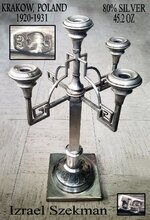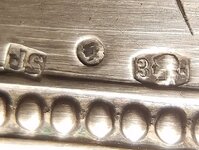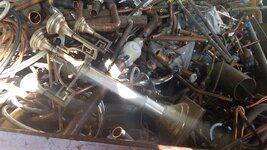UnderMiner
Silver Member
- Jul 27, 2014
- 3,818
- 9,726
- 🥇 Banner finds
- 2
- Detector(s) used
- Minelab Excalibur II, Ace 250
- Primary Interest:
- All Treasure Hunting
In September of 1939 Nazi Germany invaded Poland and started WWII. The Polish people had no time to evacuate or flee and quickly found themselves residents of an oppressive fascist state. Poland's Jewish population which was the largest in Europe at the time, was particularly hard hit. All Jews were forced to register themselves, their family members, and all of their belongings. Slowly the Jews of Poland were deprived of their businesses, homes, and possessions. All of it was confiscated. The Nazi regime moved the Jews into ghettos shortly after and then sent them off to work and die in concentration camps - one of the most notorious being the Kraków-Płaszów Concentration Camp in Krakow, Poland.
I found this candelabra at a junk yard yesterday. It was buried in a bin full of pipes which were to be recycled. When I saw it I knew it had to be fake simply because it was way too large to be made of real silver, but something about it made me think, so I spent the next 10 minutes carefully digging it out from under the pipes. With the large candelabra now in my hands I turned it around and round looking it all over for any marking that would either confirm or deny its' composition. That's when I saw it - it was a mark I recognized - a mark I had only seen once before several years prior but I immediately knew - it was a Polish silver hallmark for 80%, and it was the style used from 1920-1931.


Flabbergasted at the size (2 feet tall), weight (1,281g/45.2oz), and age of the piece I immediately began to search for a matching piece if there was one, but I didn't find anything else of value. When I got home with the piece I did some research and discovered what I had thought from the start - this piece was of Jewish origin as the maker was a man named Izrael Szekman. Izrael Szekman operated in Krakow, Poland. He is registered as being a silversmith until 1939. He would have made this piece some time between 1920-1931 according to the style of the maker's mark. The piece is hallmarked with a "k" standing for Krakow and a "3" standing for the third Polish standard of silver - the 80% standard.

Izrael Szekman produced silver for the Jewish community of Krakow and it is highly likely this piece belonged to a very wealthy Jewish family in Krakow (Jews made up 1/4th of all Krakow residents at the time). Izrael Szekman's work as a silversmith came to an abrupt end in 1939, there are no details as to why but it was likely because of the German invasion of Poland that same year.
As it was in the bin seconds after I dug it out:

Now for some historic speculation of how this Jewish candelabra from 1920's-1930's Krakow could have come to rest under a pile of pipes in a New York junk yard. This candelabra is in wonderful condition apart from one thing - one of the candle holders is missing. It is not only missing, but it was at some point completely and violently torn off. There are signs that someone tried to repair the broken piece with a lead-based solder - it didn't work. The edges of the broken piece of silver are still jagged and any repair work done to this piece in the past would have been by an extremely inexperienced person. This has lead me to hypothesize that the original owner was not in possession of this piece when the repair attempt was made - if they could afford such a valuable piece they would have certainly had it professionally repaired.
Another thing I have noticed - unlike high-purity silver like 92.5% sterling, this candelabra is 80%. 80% silver is extremely strong compared to Sterling. It does not dent or scratch as easily as Sterling. If you were to drop this candelabra down a flight of stairs it would not break, it just would not - it's a very solid piece, even being buried under the pipes did no damage to it. So what caused the one candle holder to break? I'll tell you what broke it - it was ripped out of someone's hands. Someone was holding it by the candle holder piece and another person was holding it from the center shaft, they both pulled as hard as they both could and it broke. Given the time, place, and events happening I do not think it is far fetched at all to conclude that this candelabra was taken by force from a Jewish family by the Germans in 1939 Krakow. There were 60,000 Jews in Krakow - 25% of the population. By the war's end there were no Jews in Krakow. The very word "Krakow" is now synonymous with death as the Krakow Concentration camp was built there. Pretty much the only Jews to survive from Krakow were the 1,200 that Oskar Schindler selected to work in his enamelware factory which was located just 3 miles down the road (it's now a museum at Lipowa 4, 30-702 Kraków, Poland).
So just the Facts: It is made of 80% silver and was constructed by Izrael Szekman, a Jewish silversmith in Krakow some time between 1920 and 1931. It was violently broken at some time and a very poor repair attempt was made which failed. At some point in the last week in December of 2017 someone found this candelabra laying around somewhere in their home and was so inexperienced with silver that they saw the broken piece and simply concluded that it was broken and therefore worthless - and they threw it in the trash to be recycled. I found it under the pile of pipes and rescued it.
Conjecture: It was stolen from a Jewish family by the Nazi regime after the 1939 invasion of Poland. Who ever owned it put up a fight when it was being taken and the silver candle holder was torn off in the struggle. After the war it was taken back to New York by someone who had either stolen it from the Germans, traded it, or were the original thieves themselves. Who ever had it later in its existence never cared for it that much as it was never repaired properly and it was eventually just thrown into the trash. Sad.
The future of the piece: It will have a new beginning. I will keep it in the current state it is in. No matter the truth of how and why it ended up in its current state it is still an excellent example of Jewish silversmiths from Krakow in the final decade of Jewish existence in Krakow. The fact that it has just 4 of the original 5 candle holders should be kept as a testament to the fact that 1/5th of all Poles regardless of their race or creed were killed in WWII. 1/5th killed, 1/5th of the light - a perfect representation personified by a single historic relic.
I found this candelabra at a junk yard yesterday. It was buried in a bin full of pipes which were to be recycled. When I saw it I knew it had to be fake simply because it was way too large to be made of real silver, but something about it made me think, so I spent the next 10 minutes carefully digging it out from under the pipes. With the large candelabra now in my hands I turned it around and round looking it all over for any marking that would either confirm or deny its' composition. That's when I saw it - it was a mark I recognized - a mark I had only seen once before several years prior but I immediately knew - it was a Polish silver hallmark for 80%, and it was the style used from 1920-1931.


Flabbergasted at the size (2 feet tall), weight (1,281g/45.2oz), and age of the piece I immediately began to search for a matching piece if there was one, but I didn't find anything else of value. When I got home with the piece I did some research and discovered what I had thought from the start - this piece was of Jewish origin as the maker was a man named Izrael Szekman. Izrael Szekman operated in Krakow, Poland. He is registered as being a silversmith until 1939. He would have made this piece some time between 1920-1931 according to the style of the maker's mark. The piece is hallmarked with a "k" standing for Krakow and a "3" standing for the third Polish standard of silver - the 80% standard.

Izrael Szekman produced silver for the Jewish community of Krakow and it is highly likely this piece belonged to a very wealthy Jewish family in Krakow (Jews made up 1/4th of all Krakow residents at the time). Izrael Szekman's work as a silversmith came to an abrupt end in 1939, there are no details as to why but it was likely because of the German invasion of Poland that same year.
As it was in the bin seconds after I dug it out:

Now for some historic speculation of how this Jewish candelabra from 1920's-1930's Krakow could have come to rest under a pile of pipes in a New York junk yard. This candelabra is in wonderful condition apart from one thing - one of the candle holders is missing. It is not only missing, but it was at some point completely and violently torn off. There are signs that someone tried to repair the broken piece with a lead-based solder - it didn't work. The edges of the broken piece of silver are still jagged and any repair work done to this piece in the past would have been by an extremely inexperienced person. This has lead me to hypothesize that the original owner was not in possession of this piece when the repair attempt was made - if they could afford such a valuable piece they would have certainly had it professionally repaired.
Another thing I have noticed - unlike high-purity silver like 92.5% sterling, this candelabra is 80%. 80% silver is extremely strong compared to Sterling. It does not dent or scratch as easily as Sterling. If you were to drop this candelabra down a flight of stairs it would not break, it just would not - it's a very solid piece, even being buried under the pipes did no damage to it. So what caused the one candle holder to break? I'll tell you what broke it - it was ripped out of someone's hands. Someone was holding it by the candle holder piece and another person was holding it from the center shaft, they both pulled as hard as they both could and it broke. Given the time, place, and events happening I do not think it is far fetched at all to conclude that this candelabra was taken by force from a Jewish family by the Germans in 1939 Krakow. There were 60,000 Jews in Krakow - 25% of the population. By the war's end there were no Jews in Krakow. The very word "Krakow" is now synonymous with death as the Krakow Concentration camp was built there. Pretty much the only Jews to survive from Krakow were the 1,200 that Oskar Schindler selected to work in his enamelware factory which was located just 3 miles down the road (it's now a museum at Lipowa 4, 30-702 Kraków, Poland).
So just the Facts: It is made of 80% silver and was constructed by Izrael Szekman, a Jewish silversmith in Krakow some time between 1920 and 1931. It was violently broken at some time and a very poor repair attempt was made which failed. At some point in the last week in December of 2017 someone found this candelabra laying around somewhere in their home and was so inexperienced with silver that they saw the broken piece and simply concluded that it was broken and therefore worthless - and they threw it in the trash to be recycled. I found it under the pile of pipes and rescued it.
Conjecture: It was stolen from a Jewish family by the Nazi regime after the 1939 invasion of Poland. Who ever owned it put up a fight when it was being taken and the silver candle holder was torn off in the struggle. After the war it was taken back to New York by someone who had either stolen it from the Germans, traded it, or were the original thieves themselves. Who ever had it later in its existence never cared for it that much as it was never repaired properly and it was eventually just thrown into the trash. Sad.
The future of the piece: It will have a new beginning. I will keep it in the current state it is in. No matter the truth of how and why it ended up in its current state it is still an excellent example of Jewish silversmiths from Krakow in the final decade of Jewish existence in Krakow. The fact that it has just 4 of the original 5 candle holders should be kept as a testament to the fact that 1/5th of all Poles regardless of their race or creed were killed in WWII. 1/5th killed, 1/5th of the light - a perfect representation personified by a single historic relic.
Last edited:
Upvote
39









